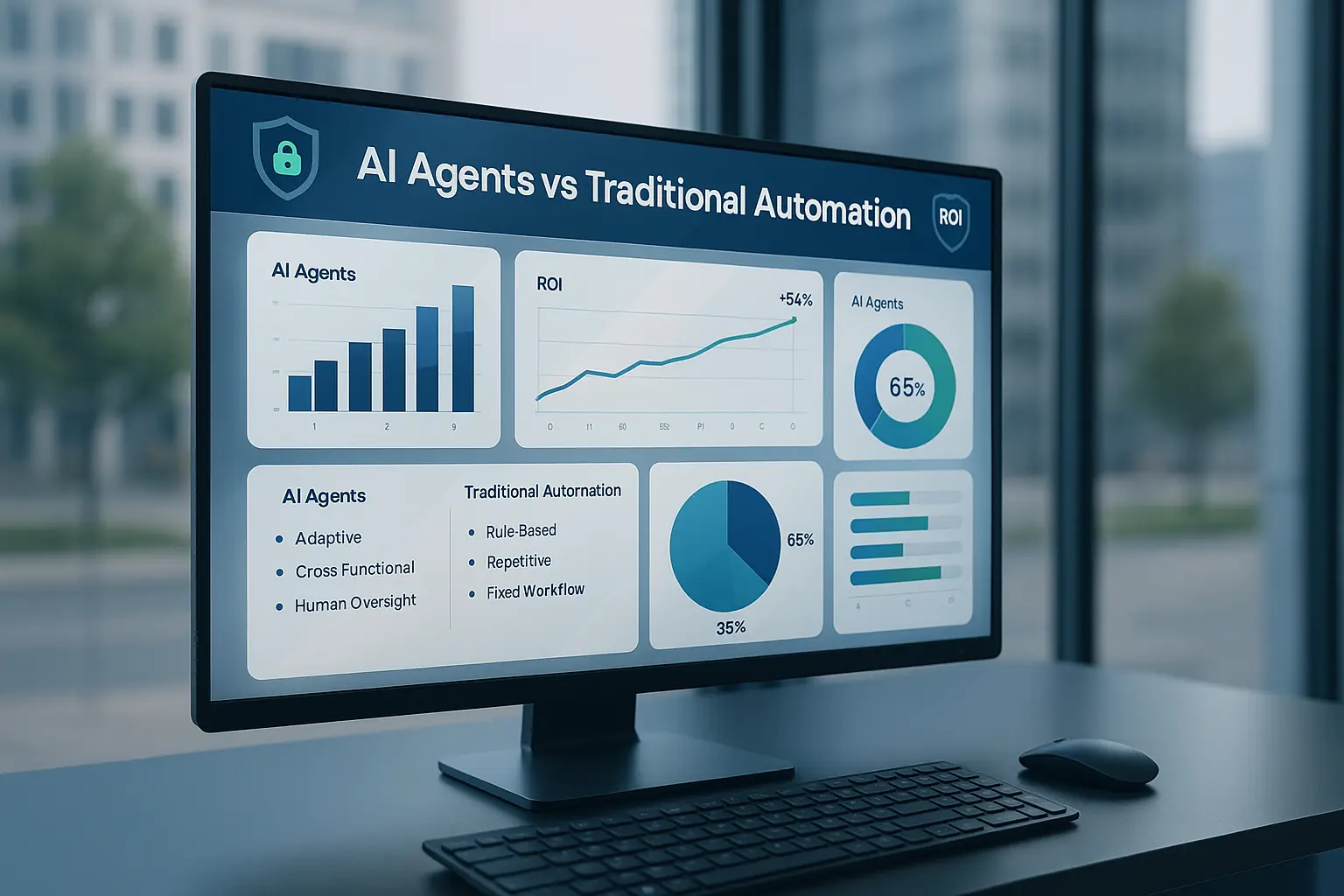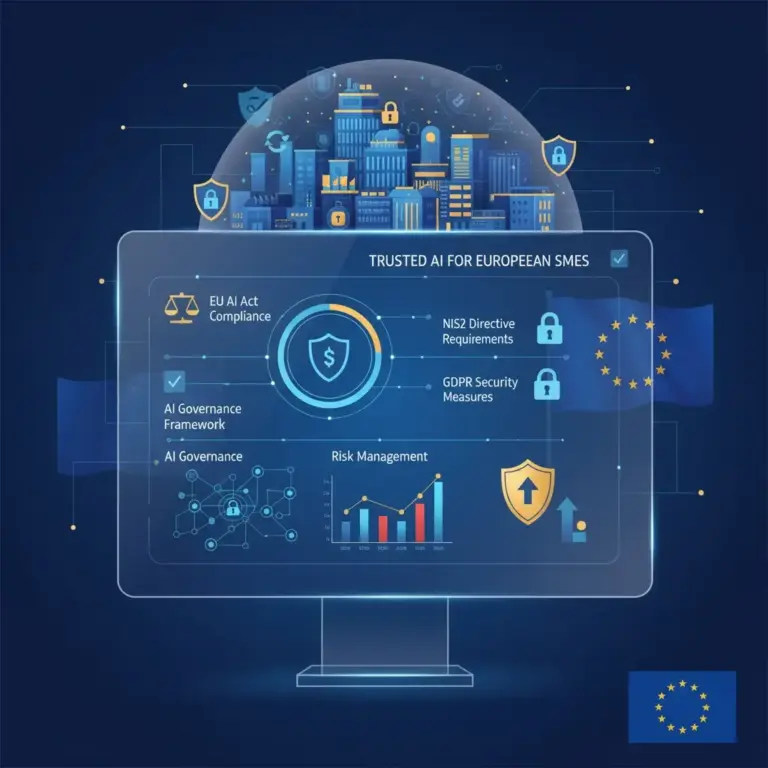Agentic AI Applications: A New Frontier for Businesses
Agentic AI Applications: A New Frontier for Businesses
Agentic AI Applications are no longer a distant sci-fi concept — they are emerging as real tools that can act autonomously, coordinate tasks, and deliver value across industries. In this post, we’ll explore what agentic AI is, 7 breakthrough use cases, strategies to adopt them, governance challenges (especially in the EU), and how Varna and Bulgaria can capitalize on this shift.
Introduction
Agentic AI applications are transforming how we think about automation — shifting from static tools to AI systems that reason, plan, and act. As businesses and cities scramble to adopt AI, understanding agentic AI applications is critical for competitive advantage. In the Bulgarian context, Varna AI is well positioned to lead innovations in agentic systems applied to maritime, logistics, and regional governance.
Here’s what we’ll cover:
- What are agentic AI applications?
- Why they matter in 2025
- 7 compelling use cases
- Strategy & implementation roadmap
- Governance, ethics & regulation
- Local context: Varna / Bulgaria
- FAQs
- Conclusion & next steps
Table of Contents
- What Are Agentic AI Applications?
1.1. Definition & Core Pillars
1.2. Difference vs Traditional AI - Why Agentic AI Applications Matter in 2025
- 7 Breakthrough Use Cases of Agentic AI Applications
3.1. Autonomous Agents for Customer Engagement
3.2. Multi-Agent Systems for Supply Chain Automation
3.3. AI Agents in Healthcare & Personalized Medicine
3.4. Smart City & Urban Infrastructure Agents
3.5. Maritime & Port Management Agents
3.6. Research / Scientific Decision Agents
3.7. Internal Operations & Workflow Agents - Strategy & Implementation Roadmap for Agentic AI Applications
4.1. Technical Stages & Infrastructure
4.2. Pilot Projects & Scaling - Governance, Ethics & Regulation for Agentic AI Applications
5.1. EU AI Act & Risk Framework
5.2. Auditing, Explainability & Oversight - Local Context: Varna, Bulgaria & the Agentic AI Opportunity
6.1. Varna AI’s Position
6.2. Example Projects & Partnerships - FAQs on Agentic AI Applications
- Conclusion + CTA
1. What Are Agentic AI Applications?
1.1 Definition & Core Pillars
Agentic AI Applications are systems in which AI models don’t just respond to prompts but actively lead sequences of actions, make decisions, coordinate sub-agents, follow goals over time, and adapt to feedback. They move beyond generative or reactive AI into autonomous, goal-oriented agents.
Core pillars include:
- Planning & decision making: ability to break down tasks, plan steps, sequence actions.
- Autonomy & goal-driven behavior: the agent has a target or objective and acts without human’s step-by-step intervention.
- Coordination & orchestration: multiple agents or modules collaborate (multi-agent systems).
- Adaptation & feedback loops: monitoring outcomes, revising strategy, learning from environment.
- Safety & constraints: enforcing guardrails, fallback behaviors, safe boundaries.
1.2 Difference vs Traditional AI
Classical AI / ML models are reactive — you give input, you get output. Even generative AI largely operates in “single shot” or “prompt + response” mode.
By contrast:
- Agentic AI chains actions (e.g. query → plan → act → monitor → repeat).
- It is stateful across sessions, remembers context and goals.
- It can allocate subtasks among agents.
- It can make trade-offs, schedule decisions, and pursue long-horizon objectives.
As MIT’s Five Trends in AI and Data Science for 2025 notes, leaders are increasingly wrestling with agentic AI as a trend: “AI programs collaborate to do real work … rather than just generating content.” MIT Sloan Management Review
2. Why Agentic AI Applications Matter in 2025
The significance of agentic AI applications in 2025 is rooted in several driving forces:
- Scaling complexity: Many business processes are interdependent and time-sensitive. Agentic systems can manage complexity across multiple domains.
- Labor & cost efficiency: Replacing sequences of repetitive tasks, coordination overhead, and decision loops with autonomous systems.
- Real-time adaptability: When environments shift (market conditions, supply chain disruptions), agents can self-adjust.
- Competitive differentiation: Early adopters will gain operational edge — especially in industries like logistics, maritime, infrastructure.
- Integration with governance frameworks: With new AI laws, systems that embed safety, explainability, and auditability will be better aligned with regulatory requirements.
Multiple sources affirm that this shift is happening: for example, AI Trends and Predictions 2025 highlights increased adoption of hybrid and agentic systems. ITPro Today+1 Meanwhile, Forbes names the rise of AI agents a core transformative trend. Forbes
Hence, organizations and regions that understand and adopt agentic AI applications early can leapfrog peers.
3. 7 Breakthrough Use Cases of Agentic AI Applications
Below are seven compelling, real (or near-future) domains where agentic AI applications have tremendous potential.
3.1 Autonomous Agents for Customer Engagement
Use case: An AI agent handles an entire customer journey: diagnosing needs, proposing solutions, scheduling services, following up, and escalating issues as needed.
- Example: A telecom AI agent that monitors user behavior, proactively offers upgrades, sets up appointments, and handles service issues — autonomously.
- Benefit: reduces human support overhead, increases customer satisfaction, enables 24/7 interaction.
3.2 Multi-Agent Systems for Supply Chain Automation
Use case: A swarm of agents coordinate inventory, logistics, procurement across suppliers, warehouses, transportation, and retail points.
- Agents negotiate optimal delivery, reroute in disruptions, dynamically allocate resources.
- For example, an agent notices a late shipment, triggers alternate sourcing, reschedules downstream deliveries.
3.3 AI Agents in Healthcare & Personalized Medicine
Use case: Agents manage patient monitoring, diagnostics, treatment scheduling, follow-up, and early warnings.
- For chronic disease patients, an agent can proactively order tests, adjust reminders, coordinate care among specialists.
- Agents can also assist in drug discovery pipelines by running experiments, adjusting parameters, and analyzing data autonomously.
3.4 Smart City & Urban Infrastructure Agents
Use case: In a smart city, multiple agents coordinate traffic flow, energy consumption, waste management, public services.
- Agents detect congestion, adjust signals, interface with public transit agents.
- Energy agents forecast demand, coordinate distributed energy resources.
- Agents can even process permits, scheduling, infrastructure maintenance autonomously.
3.5 Maritime & Port Management Agents
Given Varna’s maritime heritage, this is especially relevant.
Use case: Agents manage port operations: docking schedules, cargo handling, customs, logistics coordination, environmental monitoring.
- E.g., an agent monitors vessel ETA, schedules berth, allocates cranes, sequences loading/unloading with minimal delay.
- Coastal monitoring agents detect pollution, control drones, adapt to weather changes.
3.6 Research / Scientific Decision Agents
Use case: Agents coordinate experiments, run simulations, decide which hypothesis to test next, allocate compute, and refine strategy.
- In materials science, an agent may manage multiple subagents running experiments in parallel, interpret results, and guide next steps.
- In AI research itself, an agent could test architectures, train small models, evaluate, and iterate.
3.7 Internal Operations & Workflow Agents
Use case: Agents automate knowledge work: scheduling, email triage, generating reports, initiating approvals, coordinating teams.
- Example: An agent monitors project pipelines, triggers meetings, drafts minutes, aligns dependencies, nudges stakeholders.
- Can act as “AI project manager” autonomously.
4. Strategy & Implementation Roadmap for Agentic AI Applications
4.1 Technical Stages & Infrastructure
To build agentic AI applications, organizations typically progress through stages:
| Stage | Focus | Key Milestones |
|---|---|---|
| Foundation: context + models | Data pipelines, retrieval systems, context resolution | Build RAG, embeddings, knowledge graphs |
| Planning & action loop | Task decomposition, action modules | Integrate planner components, subagent orchestration |
| Monitoring & feedback | Performance tracking, success metrics | Implement evaluation, cleanup, fallback logic |
| Multi-agent coordination | Agents working in concert | Messaging, negotiation, task scheduling |
| Safety & governance overlay | Guardrails, audit, constraints | Logging, sanction module, human overrides |
Technical enablers include:
- Retrieval-augmented generation (RAG) or contextual AI to ground decisions. Wikipedia
- Knowledge graphs & memory modules
- Planner / hierarchical task decomposition
- Inter-agent messaging / protocols
- Safe execution sandbox / constraints / simulate-check loops
- Explainability layers and audit logs
4.2 Pilot Projects & Scaling
A recommended roadmap:
- Select focused pilot domain (e.g. port operations, internal workflow).
- Build a minimal viable agent (MVA) with limited scope, high traceability.
- Simulate & sandbox before real-world deployment.
- Monitor with human-in-the-loop oversight.
- Iterate, expand scope, add more agents/modules.
- Scale horizontally (across domains) and vertically (more autonomy).
- Continuously embed governance, safety, and logging.
5. Governance, Ethics & Regulation for Agentic AI Applications
5.1 EU AI Act & Risk Framework
Agentic AI applications often reside in higher-risk categories because of their autonomous, goal-driven nature. The upcoming EU AI Act is expected to impose stricter obligations on transparency, auditing, human oversight, and safety. arXiv+1
In practice:
- Agents must explain decisions (explainability).
- Critical actions may require human approval (human-in-the-loop).
- Logging and audit trails must be comprehensive.
- Risk assessments before deployment.
- External oversight or certification might be required.
5.2 Auditing, Explainability & Oversight
To manage risks:
- Build explainability modules so agents can justify decisions.
- Use simulation / “what-if” testing before deploying decisions.
- Include fail-safe or fallback behavior in uncertain states.
- Maintain comprehensive logs / audit trails of agent actions.
- Use red-teaming and adversarial testing to probe vulnerabilities.
6. Local Context: Varna, Bulgaria & the Agentic AI Opportunity
6.1 Varna AI’s Position
Varna AI — as the name implies — is well placed to lead in agentic AI applications, especially given Varna’s push into digital transformation and maritime tech. aimarketingbg.com/+2varnaai.com+2
Possible strategic edges:
- Proximity to maritime and port operations (natural testbed for agentic agents).
- Local talent and regional support for AI / tech initiatives.
- Bulgarian AI startups raising external funding and scaling globally. aimarketingbg.com/
- National incentives for AI innovation clusters.
6.2 Example Projects & Partnerships
- A proof-of-concept port scheduling agent in Varna that coordinates berth, cargo flows, weather adaptation.
- Collaboration with universities & local government to pilot smart city agentic modules (traffic, energy, waste).
- Partnering with Bulgarian startups building domain-specific agents (healthcare, logistics) to co-develop.
- Engage with EU or national AI grants to fund agentic AI infrastructure and labs.
By anchoring in local domain expertise (maritime, infrastructure) and combining with global trends (agentic AI, governance), Varna AI can stand out.
7. FAQs on Agentic AI Applications
Q1: What distinguishes agentic AI applications from chatbots or generative tools?
A: Chatbots/generative tools respond to direct prompts. Agentic AI applications initiate, plan, act autonomously, maintain state, coordinate over time, and pursue goals — not just respond.
Q2: Are agentic AI applications safe? What about risks?
A: There are risks — drift, unintended actions, ethical boundary violations. Safety requires constraints, human oversight, logging, fail-safes, audits, red-teaming, and regulatory compliance (e.g., EU AI Act).
Q3: Which industries will benefit most from agentic AI applications first?
A: Logistics & supply chain, smart infrastructure, maritime operations, internal enterprise automation, and R&D / scientific workflows are early domains.
Q4: How costly is it to build an agentic AI application?
A: Costs vary widely: starting with pilots is feasible with moderate investment (compute, data, architecture). Scaling multi-agent systems with robust safety & governance layers is more expensive.
Q5: How can small or mid-sized organizations adopt agentic AI applications?
A: Start small — pick a narrow use case, build a minimal viable agent, integrate human oversight, measure impact, then scale. Use modular architectures and open frameworks.
8. Conclusion & CTA
Agentic AI applications represent a new frontier in AI — where systems don’t just respond, but act, plan, and coordinate autonomously. For organizations, cities, and regions, mastering this shift can yield powerful advantages.
If you’re ready to explore agentic AI applications for your domain (maritime, logistics, internal operations, or city tech), Varna AI can help architect, build, and safely deploy them.
Get in Touch →
Let’s shape the future together.







